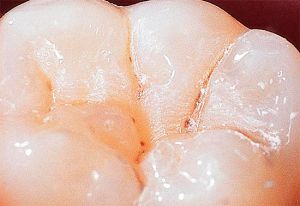 Caries, which affects the fissures of the teeth, is considered one of the most common diseases of dentin.
Caries, which affects the fissures of the teeth, is considered one of the most common diseases of dentin.
At first glance, not very noticeable and dangerous, it is nevertheless able to completely destroy the tooth, in the event that you do not pay attention to it.
Contents of
- What is a fissure?
- Complex of provoking factors
- Stages of development and nature of symptoms
- Diagnostic methods
- Stages of treatment
- Warning and armed with
- Hidden and obvious dangers
What is a fissure?
These are peculiar grooves in the tooth tissues that are present on its chewing surface. These depressions are difficult to clean, because of which they accumulate microbes, which are the main cause of the appearance of caries of this kind.
The chewing sequence of molars is most often affected, because they contain fissures, which expand to the middle of the dentin. Due to their peculiarities, the dentist can not always carefully examine the condition of the teeth and properly clean them from plaque.
In addition, this kind of caries is not a rare phenomenon in children, during the appearance of milk teeth, which do not yet have the necessary concentration of minerals, which provides their strength.
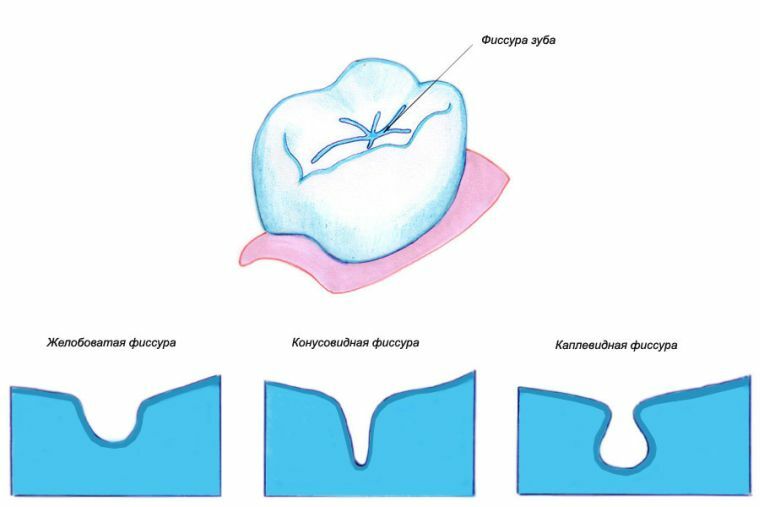
Complex of provoking factors
As a rule, dentists distinguish two groups of prerequisites, which can lead to the appearance of the disease.
Nonspecific factors:
- improper oral hygiene, including ineffective( dangerous) toothpastes and brushes;
- accelerated multiplication of bacteria on the fissure surface;
- improper nutrition, which can include a lack of raw fruits and vegetables, as well as an excess of carbohydrates;
- deficiency of vitamins, which play an important role in enamel strengthening;
- intrauterine problems with the formation of dentin;
- weak immunity and impairment in its work;
- of the GI tract.
Specific causes:
- decrease in the mineral constituent of the enamel;
- physiological thinning of tissues inside the fissure, in comparison with the main surface of the teeth;
- appearance of plaque in the grooves and, as a consequence, the presence of conditions for the development of microbes;
- microscopic enamel damage due to the use of certain products;
- the presence of strong physiological depressions in the tissues of the tooth, of which it is difficult to clean the plaque.
Stages of development and nature of symptoms
Caries fissure on the path of its development goes through several stages:
- change in the color of the enamel;
- teeth deepening lose their structure and gradually become thinner;
- begins the destruction of dentin.
Naturally, every patient is interested in the timely diagnosis of tooth decay, in order to prevent tooth loss. In order for 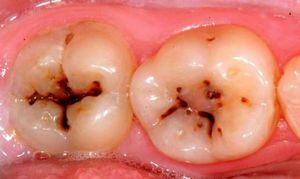 to identify the disease on its own, it is important to monitor your own sensations and pay attention to the following symptoms that may indicate the presence of fissure caries( the characteristic appearance of the disease in the advanced stage in the photo on the right):
to identify the disease on its own, it is important to monitor your own sensations and pay attention to the following symptoms that may indicate the presence of fissure caries( the characteristic appearance of the disease in the advanced stage in the photo on the right):
- feeling of pain during consumption of acute or saline, hot or cold food: this sign is evidence of the presence of an average degree of injury;
- chewing solid food can bring unpleasant sensations: this indicates the presence of the disease in the deep stage;
- the appearance of pains of a pulsating nature at night, can speak of a serious lesion of the tooth tissues, which led to the appearance of pulpitis.
Fissure caries is a disease that develops imperceptibly and quickly, which is why it is so important to conduct diagnostics in time to start timely treatment. This is necessary not only to relieve the patient of pain and discomfort, but also to preserve the dentition.
Diagnostic Methods
For the purpose of timely detection of the disease, dentists have developed a list of methods that allow you to carefully assess the condition of the enamel and detect damage to the dental grooves:
- If the grooves on the teeth are not too deep, the specialist conducts their visual inspection and examination using a dental probe .However, this method is not always effective, moreover, it is able to break the integrity of the enamel( if the grooves go deep into the tooth, then there is a possibility of damage).
- X-ray image of allows to evaluate the state of dentin in cases when there are suspicions of the presence of caries of this kind. It is especially effective in the defeat of fissures of medium and high degrees of complexity. As a rule, it is used to study teeth, the indentations on which are closed.
- laser fluorescence makes it possible to evaluate the condition of grooves most efficiently, however
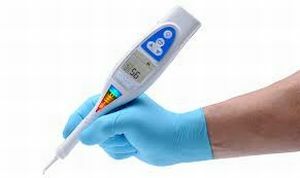
is a special electric device for diagnosing fissure fissure
by an expensive method that is not available to every clinic.
- In order to determine the depth of lesions of the dental grooves, the method is used, which involves the use of a special drill. This minimally affects enamel, which allows not only to estimate the area of carious effect, but also to clean the layer of plaque.
- Use of electrical devices to identify foci of carious damage to the tooth surface.
Stages of treatment of
It should be noted that fissure caries is a fairly common phenomenon, therefore a method has been developed for its treatment that has been tested for years and millions of cured patients.
Stages of treatment:
- removal of existing carious deposits in dental grooves;
- filling of the tooth sections, on which the layer of bacteria was removed;
- filling with fissure filling material and their sealing;
- creation of the necessary relief of the tooth, to form the right bite.
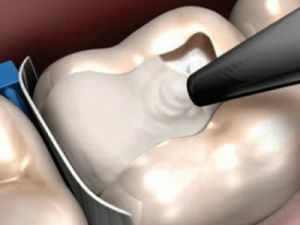 In addition, the use of cultured inserts is actively used, which replace the chewing part of dentin. Such designs can be made of various materials, among which ceramics and platinum are very popular.
In addition, the use of cultured inserts is actively used, which replace the chewing part of dentin. Such designs can be made of various materials, among which ceramics and platinum are very popular.
In this case, after the treatment of caries, a mold is made, on the basis of which a tab is fixed, fixed on the surface of the tooth.
Other treatment methods should be noted:
- invasive : involves the professional cleaning of furrows, followed by their etching with special substances and sealing with fluorine-containing preparations;
- non-invasive : composite and glass-ionic agents are used, most often this type of treatment is performed on the milk teeth.
Warned and armed with
Preventive measures to prevent the appearance of fissure caries are divided into two large groups.
Self-contained:
- diet, which implies the use of solid food, as well as a sufficient number of necessary minerals and vitamins;
- conducting competent oral hygiene, the use of pastes with antibacterial effect, containing minerals, contributing to enamel strengthening;
- increase in the intake of fluoride in the body;
- visit the dentist at least once every 6 months.
Medical:
- sealing fissure, which allows you to close the entrance for pathogenic bacteria deep into the enamel depressions - for carrying out the
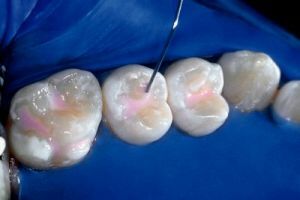 procedure, special materials are applied that are applied to the pre-cleaned surface of the teeth;
procedure, special materials are applied that are applied to the pre-cleaned surface of the teeth; - carrying out remineralizing procedures( medical varnishes containing fluorine and calcium can be used), which are most often directed to molars;
- enrichment of dentine with fluoride, as an independent application of toothpastes, and at the reception of a specialist with certain manipulations;
- mandatory rinsing of the oral cavity at home with products containing Chlorhexidine and other substances that destroy bacteria;
- reception of complexes of vitamins, with an emphasis on the content of calcium and fluoride, especially during the seasonal necessity;
- obligatory cleaning of fissures by a dentist.
Hidden and obvious dangers of
Teeth that are not given sufficient attention, as a rule, bring their owner a lot of trouble. That is why it is important to visit a competent specialist on a regular basis, who will necessarily conduct a study of dental cavities, followed by their cleaning and treatment, if necessary.
If we treat neglect of caries in fissures, then we can get such unpleasant consequences:
- penetration of microbes into deep layers of dentin;
- increased pain;
- inflammation of the pulp;
- tooth loss.
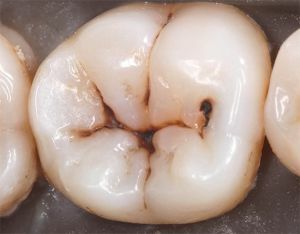 Summing up, it should be noted that fissure caries is a common dental problem, which in most cases leads to a significant destruction of dentin.
Summing up, it should be noted that fissure caries is a common dental problem, which in most cases leads to a significant destruction of dentin.
To prevent such a development of events, it makes sense to regularly visit a qualified dentist who carefully, with the use of modern techniques, will clean the chewing surface of the teeth. Because the timely cleaning of the dental grooves can contribute to the preservation of oral health in the future.
